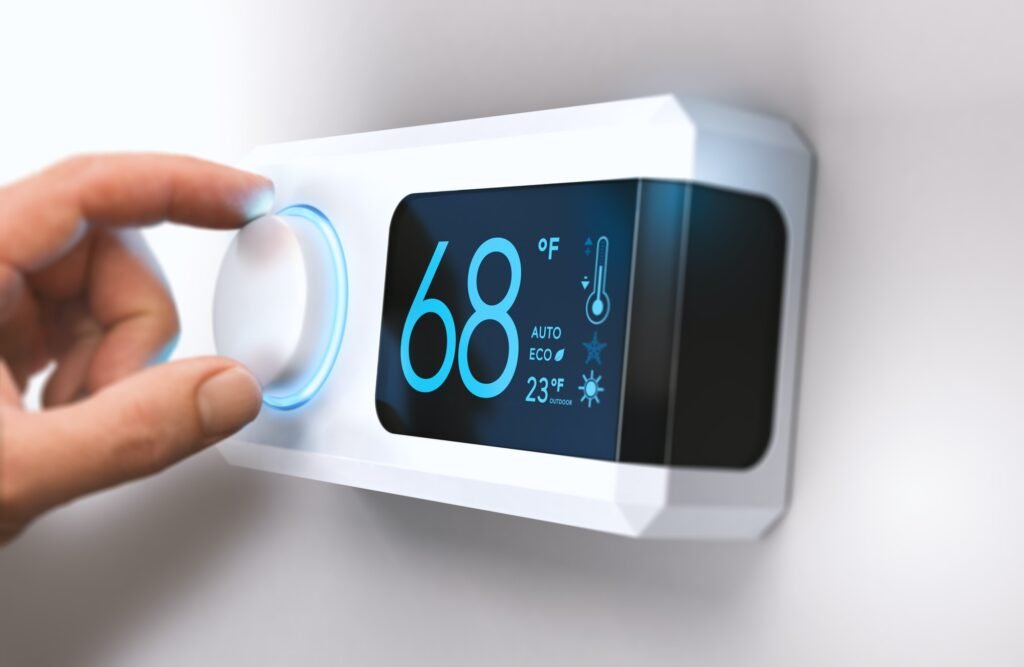In this age of interconnected devices, transforming your home into an energy-efficient haven has never been simpler. Embracing smart home technologies isn’t simply about enhancing convenience; it serves as a gateway to effective energy management, leading to significant savings on your household utility bills. Here’s a comprehensive guide covering everything you need to know about smart home energy savings, exploring key aspects and strategies to make your home smarter and more energy-efficient.
Understanding Smart Home Energy Efficiency
Smart home energy efficiency involves employing technology and automation to streamline household energy usage. This integration encompasses intelligent devices like smart thermostats, energy-efficient lighting, and appliances designed with power-saving features, all working together as a unified system. The primary goals are twofold: enhancing overall energy performance while minimizing waste, all while ensuring or improving home comfort. This comprehensive approach relies on real-time data and automation for informed decision-making, resulting in significant cost savings and a more sustainable living environment. Understanding smart home energy efficiency requires recognizing the seamless collaboration between technology and energy management. It’s about creating a home ecosystem where interconnected devices adapt dynamically to usage patterns and external factors, strategically minimizing energy consumption and promoting both economical and environmentally friendly living.
Benefits of Embracing Smart Home Energy Solutions

Embracing smart home energy solutions brings forth a multitude of advantages that transcend mere convenience. Here are some compelling benefits:
1. Cost Savings
One of the primary benefits is reduced energy consumption, leading to lower utility bills. Smart devices optimize usage, ensuring that energy is used more efficiently, which can translate into substantial long-term savings.
2. Environmental Impact
Smart home energy efficiency contributes to a greener environment by minimizing energy waste. Reduced energy consumption translates to lower carbon emissions and a smaller ecological footprint, promoting sustainability and environmental conservation.
3. Convenience and Comfort
Smart devices enhance the comfort and convenience of daily living. From automated climate control to adaptive lighting, these systems adapt to user preferences, creating a more comfortable living environment while maintaining energy efficiency.
4. Remote Control and Monitoring
Many smart home devices allow remote control and monitoring through smartphone apps. This feature empowers homeowners to manage and optimize energy usage even when they are away, providing a heightened level of control and awareness.
5. Long-Term Investment
While there may be an initial cost to invest in smart home devices, the long-term benefits often outweigh the upfront expenses. The energy savings and potential increase in home value make it a sound and forward-looking investment.
6. Data-Driven Insights
Smart home energy monitoring systems provide real-time data and insights into energy usage patterns. This information empowers homeowners to make informed decisions about energy consumption and identify areas for further optimization.
7. Integration and Automation
Smart devices often integrate seamlessly with each other, creating an interconnected home ecosystem. Automation allows devices to work together intelligently, optimizing energy usage without requiring constant manual intervention.
8. Contribution to Energy Grid Stability
Some smart home systems, like smart thermostats, can contribute to energy grid stability by participating in demand response programs. This helps balance energy demand during peak times, benefiting the overall efficiency of the energy grid.
Also Read: Fortify, Protect, Connect: A Comprehensive Guide to Smart Home Security
Smart Home Energy-Saving Devices
In an age where connectivity is king, making your home smarter can lead to significant energy savings. From intelligent thermostats to power-monitoring plugs, a plethora of devices can help you optimize energy consumption. Here are several notable smart home energy-saving devices:
1. Smart Thermostats: Precision Climate Control
Overview: Smart thermostats, such as Nest or Ecobee, learn your heating and cooling preferences over time. They optimize temperature settings based on your behavior, ensuring energy efficiency without sacrificing comfort.
Key Benefits:
– Remote control and monitoring via smartphone apps.
– Energy-saving modes and adaptive algorithms for efficient climate control.
– Integration with voice assistants and other smart home devices.
2. Smart Lighting Systems: Illuminating Efficiency
Overview: Smart lighting solutions, like Philips Hue or LIFX, offer energy-efficient alternatives to traditional bulbs. They can be controlled remotely and programmed for specific schedules, reducing unnecessary energy consumption.
Key Benefits:
– LED bulbs for energy efficiency and long lifespan.
– Motion sensors to activate lights only when needed.
– Color temperature adjustments for ambiance and productivity.
3. Smart Power Strips: Combatting Vampire Energy
Overview: Smart power strips, such as TP-Link Kasa or Belkin Wemo, prevent standby power consumption. They cut off power to devices when not in use, eliminating energy wastage from idle electronics.
Key Benefits:
– Individual outlets that can be controlled remotely.
– Energy monitoring features to track usage.
– Timers and schedules for automated power management.
4. Smart Home Energy Monitors: Real-Time Insights
Overview: Devices like Sense or Eyedro provide real-time data on your home’s energy consumption. They help identify energy-hungry appliances, allowing you to make informed decisions to improve efficiency.
Key Benefits:
– Detailed insights into energy usage patterns.
– Notifications for abnormal energy spikes or device malfunctions.
– Integration with other smart devices for coordinated energy management.
5. Smart Plugs: Transforming Ordinary Devices
Overview: Smart plugs, such as TP-Link or Wemo Smart Plugs, convert traditional appliances into smart devices. They enable remote control, scheduling, and energy monitoring for any plugged-in device.
Key Benefits:
– Turn non-smart devices into remotely controlled ones.
– Set schedules for automatic on/off cycles.
– Monitor energy usage and costs for individual devices.
6. Smart Window Treatments: Energy-Efficient Shades
Overview: Smart blinds or shades, like those from Lutron or IKEA, can automatically adjust based on sunlight and outdoor temperature. This helps regulate indoor temperatures and reduces the need for HVAC systems.
Key Benefits:
– Automated adjustments for optimal natural light and temperature.
– Integration with other smart devices for coordinated home automation.
– Energy savings through reduced reliance on heating and cooling systems.
7. Smart HVAC Systems: Intelligent Heating and Cooling
Overview: Next-gen HVAC systems, such as those from Carrier or Lennox, utilize smart technology for efficient heating and cooling. They adapt to your preferences, optimize energy usage, and can be controlled remotely.
Key Benefits:
– Adaptive temperature control based on occupancy and behavior.
– Remote monitoring and control via smartphone apps.
– Energy-efficient modes and scheduling options.
8. Smart Water Heaters: Efficiency in Every Drop
Overview: Devices like Rheem EcoNet or Aquanta make water heating more efficient. They enable remote control, scheduling, and adaptive features to reduce energy consumption while providing hot water on demand.
Key Benefits:
– Smart scheduling for optimized heating cycles.
– Energy monitoring to track water heating costs.
– Integration with other smart home systems for coordinated efficiency.
9. Smart Solar Inverters: Harnessing Solar Power
Overview: Solar inverters, such as those from Enphase or SolarEdge, optimize the conversion of solar energy. They monitor and manage the performance of solar panels, ensuring maximum energy production.
Key Benefits:
– Real-time monitoring of solar energy production.
– Optimization of energy storage and consumption.
– Remote control and troubleshooting features.
10. Smart Assistants: Seamless Control
Overview: Smart voice-activated assistants like Amazon Alexa or Google Assistant can integrate with various smart home devices. This ensures devices are only active when necessary, contributing to overall energy efficiency.
Key Benefits
– Hands-free control for various smart devices.
– Integration with a wide range of smart home platforms.
– Energy-efficient voice commands for device control.
11. Smart Ceiling Fans: Efficient Air Circulation
Overview: Smart ceiling fans, like those from Hunter or Haiku, can be controlled remotely and programmed to operate based on occupancy and temperature. This ensures energy-efficient air circulation.
Key Benefits:
– Remote control and scheduling for optimized usage.
– Integration with other smart devices for coordinated climate control.
– Energy-efficient fan speed adjustments.
12. Smart Leak Detectors: Preventing Water Waste
Overview: Devices like Moen Flo or Samsung SmartThings Water Leak Sensor can detect leaks and prevent water damage. By alerting you to potential issues, they help conserve water and reduce the energy required for water heating.
Key Benefits:
– Early detection of leaks to prevent water waste.
– Integration with other smart home systems for automated responses.
– Remote monitoring and alerts via smartphone apps.
13. Smart Sprinkler Controllers: Watering with Precision
Overview: Smart sprinkler controllers, such as Rachio or Orbit B-Hyve, optimize watering schedules based on weather conditions and plant needs. This reduces water waste and promotes efficient irrigation.
Key Benefits:
– Weather-based adjustments for precise watering.
– Remote control and monitoring via smartphone apps.
– Integration with weather data for automated watering decisions.
Strategies for Maximizing Smart Home Energy Savings
Efficiently harnessing the potential of smart home technology involves implementing strategic approaches that optimize energy consumption while ensuring comfort and convenience. Here are key strategies to maximize smart home energy savings:
- Temperature Optimization
Set programmable thermostats to adjust temperatures based on occupancy patterns, optimizing heating and cooling when needed and reducing energy usage when spaces are unoccupied.
- Efficient Lighting Practices
Utilize natural light whenever possible, install energy-efficient LED bulbs, and employ smart lighting systems with dimmers and timers to control and minimize unnecessary lighting usage.
- Smart Appliances Management
Choose energy-efficient appliances and utilize their scheduling features to run during off-peak hours, reducing electricity consumption without compromising functionality.
- Home Energy Audits
Conduct regular assessments to identify areas of energy wastage or inefficiency. This allows for targeted improvements and ensures optimal energy-saving practices throughout the household.
- Power Management with Smart Strips
Employ smart power strips to automatically cut power to devices in standby mode, preventing phantom energy drain and reducing unnecessary electricity usage.
- Utilizing Energy-Saving Modes
Leverage the energy-saving modes on smart devices, such as TVs, computers, and other electronics, to reduce their power consumption during periods of inactivity.
- Optimized Water Usage
Incorporate smart leak detectors and water-saving features in faucets and showers to prevent water wastage, contributing to both energy and water conservation.
In a nutshell, Smart home energy savings are not just a fad but a pivotal step towards a sustainable and eco-friendly future. As technology continues to evolve, the intersection of convenience and conservation in smart homes becomes increasingly apparent. By adopting these innovations, not only do we make our lives more comfortable, but we also play an active role in reducing our environmental footprint. Embrace the smart revolution, and let your home lead the way to a greener tomorrow.
